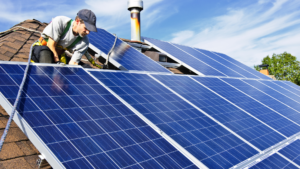
Solar Panels
The sun provides free energy every day, around 340 watts per square meter. Solar panels let you harness it to power your home. While they aren’t cheap, you can apply for Federal tax credits to offset the cost, making them an affordable option for most homeowners.
Solar panels are especially popular in southern regions, which receive less rain and more sunshine. However, solar panels benefit homeowners living up north as well. They lower power bills significantly during summer months when days are long and energy costs are high. Instead of relying on the local energy grid, homeowners can run their air conditioners using sunlight. On really hot days, it’s possible to generate more electricity than you need and sell the excess back to the power company, lowering your bills even further!
While most homeowners prefer to buy solar panels, some prefer to make them instead. Solar cells are available for purchase online. They can be mounted, racked, and wired to create a truly DIY energy infrastructure for your home. However, unless you’re a qualified electrician, don’t try and wire them into your home by yourself. Call a professional.
Reduce your carbon footprint by as much as ten percent without the headache of installing, maintaining, or repairing solar panels in your home. It’s a great option for homeowners interested in solar power, but who can’t afford to take advantage of it on their own.
Wind Turbines
Industrial wind turbines are an increasingly common sight, especially in windy regions like Texas. They average around 280 feet high, far too massive for your backyard. Fortunately, smaller turbines are available at a fraction of the height and cost. Because wind turbines work best in a specific type of environment, sadly homes in sheltered or complex terrain may not see much benefit from them.
You’ll need winds of at least 10 miles per hour to generate sufficient returns on your investment and local building codes may limit the type of turbines you can install on your land. Before setting up your turbine, research average wind speeds in your area. You may also want to hire a surveyor to work out the best location. Once you’ve found it, hire a contractor to help set up the turbine and connect it to your home’s electrical system.
Microhydropower Systems
If you have a stream or river running through your property, why not tap it to run your home? Installing hydropower is more expensive than solar or wind, but also far more reliable. It uses pipes rather than a dam. Water is pulled from the source, fed through a generator, and returned to the same location. The electricity is delivered to your home through a set of power lines and a regulator ensures your voltage remains stable, preventing sparks and shortages. Microhydropower generates around 100 watts of electricity, enough to power a large home.
Biomass
Made from wood chips, grass cuttings, paper products, food waste, solid waste, and sewage, biomass is a massive, untapped energy source your home produces every day. Rather than leave it to rot, a biomass generator lets you turn it into electricity and heat.
Organic matter releases methane as it decomposes. Burning it generates power, the same as any other fuel. Methane is a powerful greenhouse gas. Using it to run your home prevents it from polluting the atmosphere, reducing your impact on the climate.
Biodiesel
Perhaps the simplest DIY energy system. Biodiesel is a renewable resource made from soybeans, sunflower seeds, rape seeds, and palm oil. Most of the raw materials are waste products from the food industry. After they’ve been refined, they’re processed into biodiesel and burned in a generator wired to your home.
Biodiesel produces exhaust fumes, but unlike fossil fuels, it doesn’t release sulfur or benzene, a known carcinogen. Burning biodiesel also generates less carbon monoxide than conventional diesel. In fact, according to the U.S. Department of Energy, switching to biodiesel lowers your carbon footprint by 74 percent!
Agway GreenChoice™
Home-made energy is cheap, but has high start-up costs. Consumers who want to invest in cleaner alternatives, but don’t have the means to purchase them, should consider signing up for Agway GreenChoiceTM. It powers your home with clean electricity while at the same time, promoting renewable energy projects in New York, Pennsylvania, and Maryland.
Protecting Your Home’s Electrical System
DIY energy projects depend on solid wiring. Protect it with Agway’s EnergyGuardTM repair program. Fixing your electrical system can cost thousands of dollars. But with Agway, you don’t pay a dime. We pay for all covered parts instead: copper wires, outlets, switches, dimmers, circuit breakers, and breaker panels. There are no service fees or deductibles, nothing except a low monthly fee. You’re enrolled as soon as you join, so sign up today!